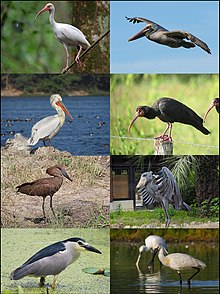Pelecaniformes
| Pelecaniformes | |
|---|---|

| |
| Scientific classification | |
| Domain: | Eukaryota |
| Kingdom: | Animalia |
| Phylum: | Chordata |
| Class: | Aves |
| Clade: | Aequornithes |
| Order: | Pelecaniformes Sharpe, 1891 |
| Suborder and Families | |
| |
The Pelecaniformes
The pelicans, shoebill and hamerkop form a clade within the order, with their next closest relatives being a clade containing the herons, ibises and spoonbills. The
Systematics and evolution
Classically, bird relationships were based solely on morphological characteristics. The Pelecaniformes were traditionally, but erroneously, defined as birds that have feet with all four toes webbed (totipalmate), as opposed to all other birds with webbed feet where only three of four were webbed. Hence, they were formerly also known by such names as totipalmates or steganopodes. The group included frigatebirds, gannets, cormorants, anhingas, and tropicbirds.[4]
Morphological study has suggested pelicans are sister to a gannet-cormorant clade, yet genetic analysis groups them with the hamerkop and shoebill, though the exact relationship between the three is unclear.[5] Mounting evidence pointed to the shoebill as a close relative of pelicans.[4] This also included microscopic analysis of eggshell structure by Konstantin Mikhailov in 1995, who found that the shells of pelecaniform eggs (including those of the shoebill but not the tropicbirds) were covered in a thick microglobular material.[6] Reviewing genetic evidence to date, Cracraft and colleagues surmised that pelicans were sister to the shoebill with the hamerkop as the next earlier offshoot.[7] Ericson and colleagues sampled five nuclear genes in a 2006 study spanning the breadth of bird lineages, and came up with pelicans, shoebill and hamerkop in a clade.[8] Hackett and colleagues sampled 32 kilobases of nuclear DNA and recovered shoebill and hamerkop as sister taxa, pelicans sister to them, and herons and ibises as sister groups to each other, with the heron and ibis group a sister to the pelican/shoebill/hamerkop clade.[9]
The current
| Pelecaniformes |
| ||||||||||||||||||||||||
Recent research strongly suggests that the similarities between the Pelecaniformes as traditionally defined are the result of
The pelecaniform lineages appear to have originated around the end of the
- Lonchodytes (Lance Creek Late Cretaceous of Wyoming, US)
- Torotix (Late Cretaceous)
- Tytthostonyx (Late Cretaceous/Early Palaeocene)
- Cladornis (Deseado Early Oligocene of Patagonia, Argentina)
- "Liptornis"—a nomen dubium
The proposed
References
- ^ Mayr, G. et al. (2018) A fossil heron from the early Oligocene of Belgium - the earliest temporally well-constrained record of the Ardeidae. Ibis, 161(1) DOI:10.1111/ibi.12600
- PMID 32781465.
- PMID 25504713.
- ^ PMID 7937906.
- S2CID 59486699.
- doi:10.1139/z95-207.
- PMID 17148284.
- S2CID 6472805.
- ^ International Ornithological Committee (2 January 2012). "Ibises to Pelicans & Cormorants". IOC World Bird Names: Version 2.11. WorldBirdNames.org. Archived from the original on 1 March 2012. Retrieved 30 April 2012.
- PMID 28369655.
- PMID 32781465.
- ^ Mayr (2003)
- ^ Mortimer (2004)
Further reading
- Bourdon, Estelle; Bouya, Baâdi & Iarochene, Mohamed (2005): Earliest African neornithine bird: A new species of Prophaethontidae (Aves) from the Paleocene of Morocco. DOI: 10.1671/0272-4634(2005)025[0157:EANBAN]2.0.CO;2 HTML abstract
- Mayr, Gerald (2003): The phylogenetic affinities of the Shoebill (Balaeniceps rex). Journal für Ornithologie 144(2): 157–175. [English with German abstract] HTML abstract
- Mortimer, Michael (2004): The Theropod Database: Phylogeny of taxa. Retrieved 2013-MAR-02.
